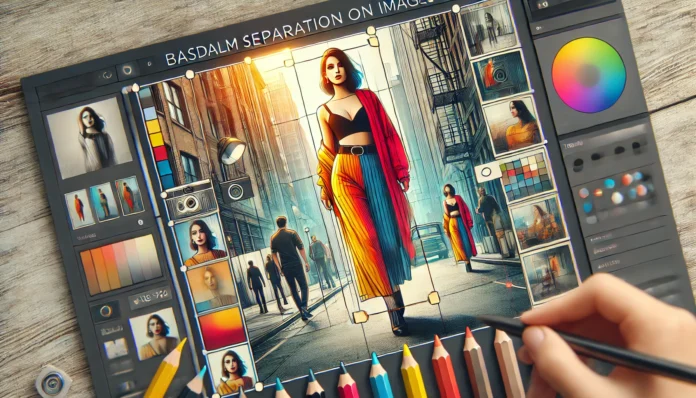Why Is Basdalm Separation on Images Important?
Imagine this: you’re scrolling through a website, and you notice an image where certain details just pop. It almost feels like parts of the image have been neatly separated, making it easy to spot the differences. That’s the magic of basdalm separation on images.
This technique, a favorite among designers and digital artists, allows you to distinguish between different sections within a single image. If you’ve ever wondered how graphic designers get that clean, crisp look, basdalm separation might be the answer. So let’s get into the real reason why this matters.
Basdalm Separation 101: What’s the Deal?
Basdalm separation on images isn’t just about splitting an image into parts; it’s about enhancing clarity. This process involves creating a contrast between various elements in a photo, so each part stands out distinctly. It’s a must-have skill for anyone looking to up their game in design. But how does it work, really?
- Sharpens Focus: It makes one part of an image clearer than another, directing the viewer’s attention.
- Improves Comprehension: By separating elements, viewers can quickly understand what they’re looking at without extra effort.
- Adds a Professional Touch: Honestly, it just looks cool. Images with basdalm separation look polished and well-thought-out.
How Does Basdalm Separation Work?
At its core, basdalm separation on images relies on contrasting colors, shapes, or textures. Think of it as a way of highlighting differences. By enhancing these contrasts, you can make parts of the image appear more prominent.
Breaking It Down
Let’s say you have an image with a person standing against a complex background. Using basdalm separation, you could:
- Emphasize the Person: Make the person stand out by creating a sharper contrast between them and the background.
- Dull the Background: Slightly blur or desaturate the background to make sure the viewer’s eyes go straight to the main subject.
- Play with Colors: Maybe the background is a warm color, and the person’s clothes are cool tones – this contrast is a form of basdalm separation too.
Real-Life Example: Fashion Photography
In fashion photography, basdalm separation is gold. Imagine a model wearing a stunning dress against a bustling city background. To ensure that all attention goes to the outfit, photographers will often use basdalm separation techniques. They may blur the cityscape or adjust colors so the dress grabs your attention.
FAQs: Clearing Up Common Questions
Q: Is basdalm separation on images the same as masking?
Nope! While both techniques aim to isolate elements, masking involves cutting parts out, while basdalm separation emphasizes contrasts within the same frame.
Q: Can I do basdalm separation on my smartphone?
Absolutely. Plenty of apps allow you to play with contrast, saturation, and blurring to create that separated look.
Q: Do I need special software for basdalm separation?
Not necessarily. Many standard editing tools like Photoshop offer the features you need. Adjusting saturation, contrast, and blurring are the main tricks here.
Tips for Applying Basdalm Separation Like a Pro
To get the most out of basdalm separation on images, consider these quick tips:
- Start with Contrast: When editing, your first go-to should be the contrast tool. Adjusting this will give immediate separation.
- Experiment with Blur: Sometimes a slight blur on certain parts can make all the difference. Try applying it to backgrounds or areas you want to de-emphasize.
- Color Matters: Warm colors (reds, oranges) and cool colors (blues, greens) naturally separate themselves. Use this to your advantage by placing them side by side.
The Power of Basdalm Separation in Storytelling
Basdalm separation isn’t just a tool; it’s a storytelling method. Imagine you’re creating a poster for a wildlife documentary. You have a powerful image of a tiger in a dense jungle. By using basdalm separation, you can make the tiger’s vibrant colors stand out against the green, lush backdrop. It’s like saying, “Look here, this is the main character.”
When you think of it this way, basdalm separation on images transforms from a mere editing technique to a way of telling a story.
Avoiding Common Mistakes in Basdalm Separation
Like any tool, it’s easy to go overboard. Here are some pitfalls to steer clear of:
- Too Much Contrast: While a high contrast can help with separation, overdoing it can make the image look artificial.
- Overusing Blur: Remember, the blur tool is powerful but should be used sparingly. Over-blurring can make an image look low-quality.
- Ignoring the Natural Lines: Sometimes, images have natural lines that aid separation, like a horizon or a window frame. Use these to guide your edits instead of fighting them.
Wrapping It Up: Why Basdalm Separation on Images Works
Basdalm separation on images gives you control. It’s a simple yet powerful way to enhance images without adding anything extra. By making small adjustments to contrast, color, and blur, you can guide your viewer’s attention exactly where you want it to go.
Whether you’re a beginner or a pro, this technique can elevate your work. From fashion shoots to wildlife photos, basdalm separation helps to highlight what matters most in any image. And at the end of the day, isn’t that what great photography is all about?
With basdalm separation on images, you get to tell a clearer, more impactful story. And that’s a win-win for both you and your audience.
